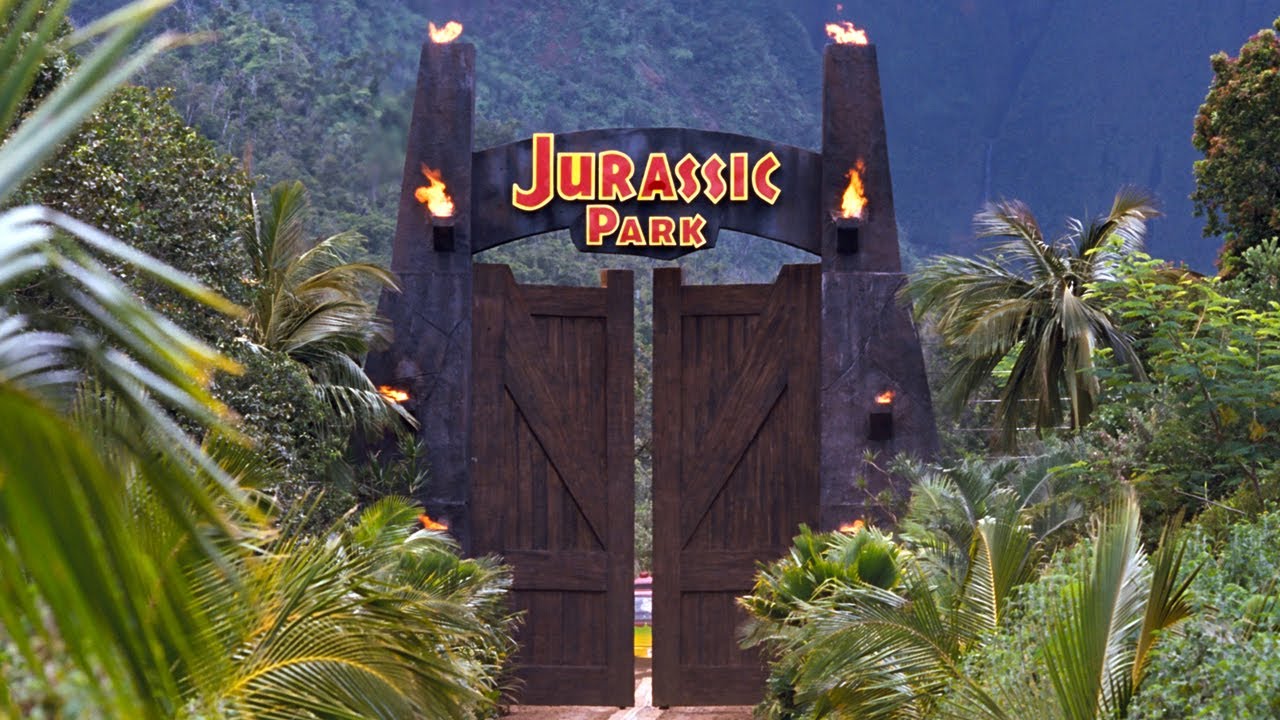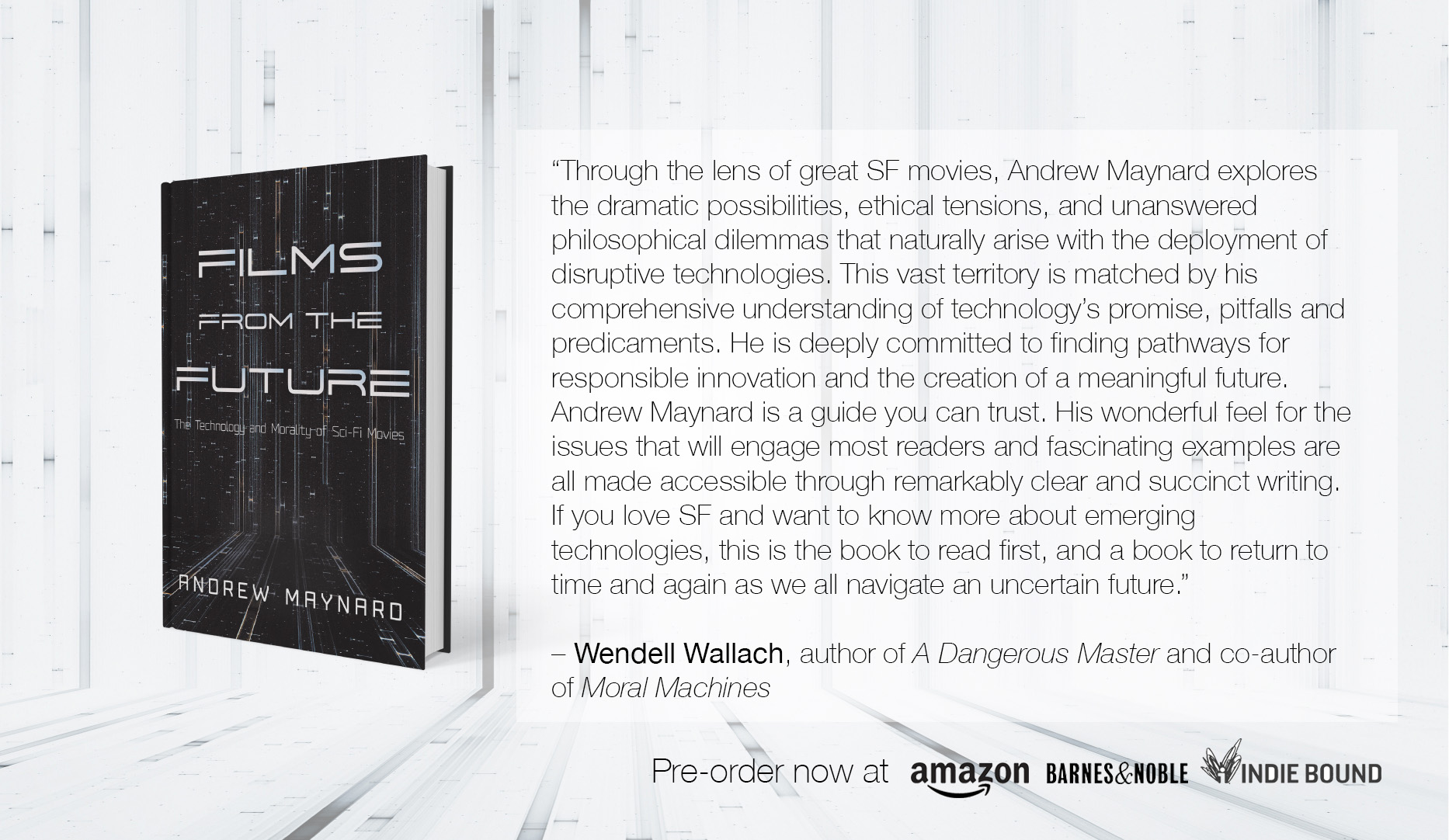Over the next several weeks, I’ll be posting weekly excerpts from Films from the Future: The Technology and Morality of Sci-Fi Movies. The book can be pre-ordered at Amazon.com
Chapter Two
The Rise of Resurrection Biology
“God help us, we’re in the hands of engineers!” — Dr. Ian Malcolm
When Dinosaurs Ruled the World
I was a newly minted Ph.D. when I first saw Jurassic Park. It was June 1993, and my wife and I were beginning to enjoy our new-found freedom, after years of too much study and too little money. I must confess that we weren’t dinosaur geeks. But there was something about the hype surrounding the movie that hooked us. Plus, we fancied a night out.
That summer, dinosaurs ruled the world. Wherever you looked, there were dinosaurs. Dinosaur books, dinosaur parks, dinosaurs on TV, dinosaur-obsessed kids. Jurassic Park seemingly tapped into a dinosaur-obsessed seam buried deep within the human psyche. This was helped along of course by the ground-breaking special effects the movie pioneered. Even now, there’s a visceral realism to the blended physical models and computer-generated images that brings these near-mythical creatures to life in the movie.
This is a large part of the appeal of Jurassic Park. There’s something awe-inspiring — awe-full in the true sense of the word — about these “terrible lizards” that lived millions of years ago, and that are utterly alien to today’s world. This sense of awe runs deep through the movie. Listening to John Williams’ triumphant theme music, it doesn’t take much to realize that under the gloss of danger and horror, Jurassic Park is at heart a celebration of the might and majesty of the natural world.
Jurassic Park is unabashedly a movie about dinosaurs. But it’s also a movie about greed, ambition, genetic engineering, and human folly — all rich pickings for thinking about the future, and what could possibly go wrong …
In 1993 when Jurassic Park was released, the idea of bringing extinct species back from the dead was pure science fiction. Back then, advances in understanding DNA were fueling the fantasy that, one day, we may be able to recode genetic sequences to replicate species that are no longer around. But by any stretch of the imagination, this was beyond the wildest dreams of scientists in the early 1990’s. Yet since the movie was made, there have been incredible strides in genetic engineering; so much so that scientists are now actively working on bringing back extinct species from the dead. And the field even has its own name: de-extinction.
More than the technology though, Jurassic Park foreshadows the growing complexities of using powerful new technologies in an increasingly crowded and demanding world. In 1993, chaos theory was still an emerging field. Since then, it’s evolved and expanded to include whole areas of study around complex systems; especially where mixing people and technology together leads to unpredictable results.
What really stands out with Jurassic Park over 25 years on though is how it reveals a very human side of science and technology. This comes out in questions around when we should tinker with technology, and when we should leave well alone. But there is also a narrative here that appears time and time again with the movies in this book, and that is how we get our heads around the sometimes-oversized roles mega- entrepreneurs play in dictating now new tech is used, and possibly abused.
These are all issues that are just as relevant now as they were in 1993, and are front and center of ensuring that the technology-enabled future we’re building is somewhere we want to live, and not one where we’re constantly fighting for our lives …
De-Extinction
In a far corner of Siberia, two Russians — Sergey Zimov and his son Nikita — are attempting to recreate the ice age. More precisely, their vision is to reconstruct the landscape and ecosystem of northern Siberia in the Pleistocene; a period in Earth’s history that stretches from around two and a half million years ago to eleven thousand years ago. This was a time when the environment was much colder than now, with huge glaciers and ice sheets flowing over much of the Earth’s northern hemisphere. It was also a time when humans coexisted with animals that are long-extinct, including saber tooth cats, giant ground sloths, and woolly mammoths.
The Zimov’s ambitions are an extreme example of “Pleistocene rewilding”; a movement to re-introduce relatively recently-extinct large animals, or their close modern-day equivalents, to regions where they were once common. In the case of the Zimov’s, the father and son team believe that, by reconstructing the Pleistocene ecosystem in the Siberian steppes and elsewhere, they can slow down the impacts of climate change on these regions. These areas are dominated by permafrost; ground that never thaws through the year. Permafrost ecosystems have developed and survived over millennia, but a warming global climate (a theme we’ll come back to in chapter 12 and the movie The Day After Tomorrow) threatens to catastrophically disrupt them, and as this happens, the impacts on biodiversity could be devastating. But what gets climate scientists even more worried is potentially massive releases of trapped methane as the permafrost disappears.
Pleistocene Park is, by no stretch of the imagination, a modern-day Jurassic Park. The dinosaurs in Hammond’s park date back to the Mesozoic period, from around 250 million years ago to 65 million years ago. By comparison, the Pleistocene is relatively modern history, ending a mere eleven and a half thousand years ago. And the vision behind Pleistocene Park is not thrills, spills, and profit, but the serious use of science and technology to stabilize an increasingly unstable environment. Yet there is one thread that ties them together, and that’s using genetic engineering to re-introduce extinct species. In this case, the species in question is warm-blooded and furry: The woolly mammoth.
The idea of de-extinction, or bringing back species from extinction (it’s even called “resurrection biology” in some circles) has been around for a while. It’s a controversial idea, and it raises a lot of tough ethical questions. But proponents of de-extinction argue that we’re losing species and ecosystems at such a rate that we can’t afford not to explore technological interventions to help stem the flow …
In 2013, Sergey Zimov was introduced to the geneticist George Church at a conference on de-extinction. Church is an accomplished scientist in the field of DNA analysis and reconstruction, and a thought-leader in the field of synthetic biology (which we’ll come back to in chapter 9). It was a match made in resurrection biology heaven. Zimov wanted to populate his Pleistocene Park with mammoths, and Church thought he could see a way of achieving this.
What resulted was an ambitious project to de-extinct the woolly mammoth. Church, and others who are working on this, have faced plenty of hurdles. But the technology has been advancing so fast that, as of 2017, scientists were predicting they would be able to reproduce the woolly mammoth within the next two years …
Could We, Should We?
Perhaps one of the most famous lines from Jurassic Park — at least for people obsessed with the dark side of science — is when Ian Malcolm berates Hammond by saying “your scientists were so preoccupied with whether they could, they didn’t stop to think if they should.”
Ethics and responsibility in science are complicated. I’ve met remarkably few scientists and engineers who would consider themselves to be unethical or irresponsible. That said, I know plenty of scientists who are so engaged with their work and the amazing things they believe it’ll lead to, that they sometimes struggle to appreciate the broader context within which they operate.
The challenges surrounding ethical and responsible research are deeply pertinent to de-extinction. A couple of decades ago, they were largely academic. The imaginations of scientists back when Jurassic Park hit the screen far outstripped the techniques they had access to at the time. Things are very different now though, as research on woolly mammoths and other extinct species is showing. In a very real way, we’re entering a world that very much echoes the “can-do” culture of Hammond’s Jurassic Park, where scientists are increasingly able to do what was once unimaginable. In such a world though, where do the lines between “could” and “should” lie, and how do scientists, engineers and others develop the understanding and ability to do what is socially responsible, while avoiding what is not?
… For all its scientific inaccuracies and fantastical scenarios, Jurassic Park does a good job of illuminating the challenges of unintended consequences arising from somewhat naive and myopic science. Take InGen’s scientists for instance. They’re portrayed as being so enamored with what they’ve achieved, that they lack the ability to see beyond their own brilliance to what they might have missed.13 Of course, they’re not fools. They know that they’re breaking new ground with bringing dinosaurs back to life, and that there are going to be risks. It would be problematic for instance if any of the dinosaurs escaped the island and survived; and they recognize this. And so, the scientists deigned them to be dependent on a substance it was thought they couldn’t get enough of naturally — the essential amino acid lysine. This was the so-called “lysine contingency”, and as it turns out, it isn’t too dissimilar from techniques real-world genetic engineers use to control their progeny …
The Butterfly Effect
Michael Crichton started playing with the ideas behind Jurassic Park in the 1980’s, when “chaos” was becoming trendy. I was an undergraduate at the time studying physics, and it was near-impossible to avoid the world of “strange attractors” and “fractals”. These were the years of the “Mandelbrot Set”, and computers that were powerful enough to calculate the numbers it contained and display them as stunningly psychedelic images. The recursive complexity in the resulting fractals became the poster-child of a growing field of mathematics that grappled with systems where, beyond certain limits, their behavior was impossible to predict. The field came to be known informally as chaos theory.
Chaos theory grew out of the work of the American meteorologist Edward Lorenz. When he started his career, it was assumed that the solution to more accurate weather prediction was better data and better models. But in the 1950’s, Lorenz began to challenge this idea. And what he found was that in some cases, minute changes in atmospheric conditions could lead to dramatically different outcomes down the line; so much so that in sufficiently complex systems it was impossible to predict the results of seemingly insignificant changes…
In 1963 when he published the paper that established chaos theory, it was a revolutionary idea — at least to scientists who still hung onto the assumption that we live in a predictable world. Much as quantum physics challenged scientist’s ideas of how predictable physical processes are in the invisible world of atoms and subatomic particles, chaos theory challenged their belief that, if we have enough information, we can predict the outcomes of our actions in our everyday lives …
Films from the Future: The Technology and Morality of Sci-Fi Movies is currently available for pre-order on Amazon.com.


